
Presents

 |
Memories from the Danton Burroughs Family Archive John Coleman Burroughs.com |
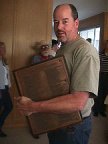 |
Edgar Rice Burroughs
Biographical Sketches II
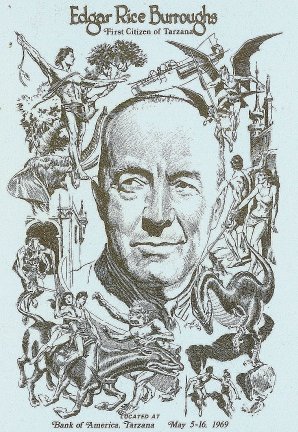
Edgar Rice Burroughs ~ First
Citizen of Tarzana
A Promotional Booklet by The Bank of America
Click for full-page images
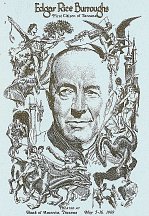
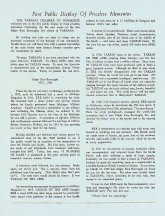
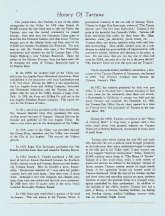
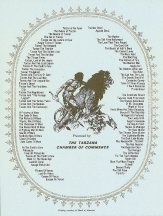
Edgar Rice Burroughs 1875 - 1950
From the day he was born, in Chicago, on September 1, 1975, until he submitted half a novel to All-Story Magazine in 1911, Edgar Rice Burroughs failed in almost everything he tried. He attended half a dozen public and private schools before he finally graduated from Michigan Military Academy. Unable to secure a commission in any military unit including the Chinese Army, he enlisted in the Seventh U.S. Cavalry but at the time of his discharge he was still a private. A succession of eighteen different jobs and business ventures followed his marriage in 1900 to Emma Centennia Hulbert, but by 1911 he was pawning his watch to buy food for his family.
Having doodled and sketched and written poetry for amusement most of his life, ERB decided to see if the public would be as receptive to his imagination as were his friends and family. His first story, written on the backs of old letterheads from bankrupt businesses, brought him $400. Today, that story, A PRINCESS OF MARS, is acclaimed as the great turning point of twentieth century science fiction.
A historical novel followed, but was rejected. Broke again, he nearly quit. But a one-line letter from his publishers kept him going. ("For Mike's sake, don't give up!"). The next story would decide his future. It was TARZAN OF THE APES.
An astonishing success upon its appearance in All-Story Magazine in 1912, TARZAN OF THE APES brought ERB a mere $700, but after being rejected by practically every major book publisher in the country it was finally printed in book form by A. C. McClurg & Company and became 1914's best seller.
A torrent of novels followed: There were stories about Venus, about Apaches, Westerns, social commentaries, detective stories, tales of the Moon and the middle of the Earth -- and more and more TARZAN books. By the time his pen was stilled, nearly 100 books bore ERB's name.
In 1918, TARZAN came to the screen. TARZAN OF THE APES, starring Elmo Lincoln, was the first film in history to gross over a million dollars. Since then, 39 TARZAN films have been produced, each of them a great financial success. Although he liked to joke about it, ERB was bitterly disappointed with the TARZAN pictures. Often, he would not even go to see them. His TARZAN was a supremely intelligent, sensitive man. His TARZAN sat in the House of lords when not other wise ranging through the upper terraces of the African jungle. His TARZAN was the truly civilized man, heroic, beautiful -- and above all, free. The world knows well the semi-literate caricature that is Hollywood's TARZAN.
By 1919, with financial security assured, ERB moved to California, where he purchased the 550 acre estate of General Harrison Gray Otis, renaming it "Tarzana Ranch." Here, he wrote prodigiously, managed the world-wide enterprise that is now Edgar Rice Burroughs, Inc. and devoted his leisure time to his family and to his beloved ranch.
ERB is remembered as a modest man who never took himself or anything else too seriously. His friends recall his ready sense of humor, his great love of the outdoors and his unbounded pride in his country, which he served at every opportunity.
In 1941 he volunteered to become America's oldest war correspondent, and returned home from the South Pacific only after suffering a series of heart attacks. Ironically, he was unable to find a home in TARZANA. Instead, he spent his remaining years as a semi-invalid in a modest house on Zelzah Avenue in Encino. It was there, on March 19, 1950 that Edgar Rice Burroughs set down his pen for the last time. His ashes were carried home to TARZANA, where, according to his own wish, they repose in an unmarked grave.
It may be that ERB made his final commentary on a long and meaningful life when he wrote the very last TARZAN story: The last line was . . .
"Thank God for everything."
~ Edgar Rice Burroughs, Inc.
EDGAR RICE BURROUGHS (September 1, 1875 - March 19, 1950), was born in Chicago, fifth of six sons of businessman George Tyler Burroughs and Mary Evaline (Zieger) Burroughs. He was the youngest of four surviving brothers and attended Chicago's Brown elementary. By 1886 he rode horseback to the Harvard School at 18th and Indiana Avenue. He was taught Greek and Latin before learning English composition.
An influenza epidemic in 1891 Chicago caused ERB's parents to send him to Idaho where older brothers Harry and George, with partner Lew Sweetser, owned the Bar Y Ranch in Cassia County. The city boy loved horses and became an expert bronco buster.
That Fall he was sent to Phillips Academy at Andover, Massachusetts. Popular, ERB was elected class president but disliked the formal curriculum and ran away. ERB's father, a Union cavalry officer during the American Civil War, believed a military school might benefit his son. At Michigan Military Academy, Orchard Lake (Fall 1892), ERB's commandant was Captain Charles King, a name he later used in his novels. ERB was on the football and cavalry teams and was editor-in-chief and artist for the student newspaper The Adjutant. He remained at Michigan Military Academy after graduating in 1896 as Assistant Commandant; a Professor of Geology, Cavalry and Gatling Gun.
ERB desired entry to West Point but failed the entrance exam (14 of 118 applicants were accepted). He enlisted in the army and was assigned duty at Fort Grant, Arizona, "B" Troop, 7th Cavalry, under the command of Colonel "Bull" Sumner. ERB's duties were "digging boulevards in the desert where no boulevards were needed" and chasing Indian outlaws without strategy or success. A bout of dysentery uncovered a heart murmur which disqualified him for an army commission. ERB obtained an honorable discharge and returned to his brothers' cattle ranch in Idaho.
Ever desirous to start his own business, he bought a stationery store in Pocatello (1898). He sold it back to the original owner at year's end. Back at his brothers' ranch he decided the cattle business was not for him. In 1898 ERB returned to Chicago to work at his father's American Battery Company.
A regular salary ($15/week) encouraged ERB to marry childhood sweetheart Emma Centennia Hulbert on January 31, 1900. Her father, Alvin Hulbert, was proprietor of the Sherman and Great Northern hotels. In 1903, ERB and Emma joined brother George in Idaho to operate a gold dredge in the Stanley Basin.
ERB later joined brother Harry's gold dredging operations near Parma, Idaho (1904) in which town he was popular enough to be elected alderman; but the gold business soon failed. ERB and Emma moved to Salt Lake City, Utah where he worked as a railroad policeman rousting hoboes and drunks from freight cars. Dissatisfied, the couple sold their belongings at auction and returned to Chicago.
From 1904 to 1908 temporary jobs included time-keeper, light bulb and candy sales, peddling Stoddard's lectures, E. S. Winslow Company accountant and, at emotional nadir, volunteering to officer in the Chinese army (never happened). Early in 1908 he landed an excellent job managing the clerical department at Sears, Roebuck & Company but felt his destiny lay elsewhere. He resigned August 1908, determined to go into business for himself.
A bleak period followed. Emma's jewelry was pawned to buy food. They lived in Oak Park when Joan was born January 1908. Hulbert, their first son, arrived August 1909, by which time ERB was office manager for Physicians Co-Operative Association. The company sold "Alcola," an alleged cure for alcoholism but the Food and Drug Administration shut them down within a year.
Alcola's president, Dr. Stace, and ERB formed the Stace-Burroughs Company which sold booklets (written by ERB) on expert salesmanship. The Stace-Burroughs Company sank without a trace.
ERB formed a new agency which sold pencil sharpeners. While agents peddled product door to door he sat in a borrowed office. Killing time, ERB checked his ads running in various pulp magazines. He read some of the fiction and decided "if people are paid for writing such rot, I can write something just as rotten."
He began his first story early in 1911. It was influenced by the popular theories of astronomer Percival Lowell. The story was so improbable he signed it "Normal Bean" to signify he was not insane. ERB sent it to Thomas Newell Metcalf, editor of All-Story, where it was accepted immediately. Metcalf changed the title to "Under the Moons of Mars" and ran it in six installments February to July 1912. A copy editor, assuming an error, changed ERB's nom de plume to Norman Bean. The pun spoiled, ERB dropped the alias permanently. He received $400 for his story, a staggering sum at the time.
Metcalf sensed untapped potential and suggested ERB write a story along the lines of Arthurian legend. ERB obliged with a Gothic romance entitled "The Outlaw of Torn." All-Story rejected it (eventually sold to Street & Smith's New Story Magazine in 1914). He had begun a third story "Tarzan of the Apes" in December 1911 and finished May 1912. Metcalf published it complete in one issue of All-Story, October 1912. ERB received $700, resulting in a decision to take up writing full time. This decision was further strengthened by the birth of a third child, John Coleman Burroughs (February 28, 1913), who would eventually illustrate twelve of his father's first editions.
During the next twelve months ERB wrote and sold eight novels.
After many rejection slips from several major publishing houses, ERB received an offer from A.C. McClurg & Company, Chicago. The company had previously rejected "Tarzan of the Apes" but the story's popularity resulted in a signed contract. ERB's first book "Tarzan of the Apes" was published June 17, 1914. It became a national best seller. McClurg published a total of 29 ERB books between 1914-1929. Most of these first editions were illustrated by J. Allen St. John, a Chicago artist now identified with the Burroughs legend.
In 1919, ERB purchased a 540-acre ranch in California's San Fernando Valley. Idyllic, ERB played at gentleman farming while solidifying a multi-million dollar industry. The ranch was named "Tarzana" and the city which sprang up around him officially took the name on December 11, 1930.
ERB routinely sold first serial rights to the pulps while retaining reprint and book rights. He was 36 when his first story was published in 1912. Eleven years later ERB incorporated himself and by 1931 decided to publish his own books to maximize earnings. ERB succeeded admirably and ERB, Inc. published 24 first editions.
In 1934, their children grown, ERB and Emma's divorce became final December 6, 1934. Four months later on April 4, 1935 he married Florence (Gilbert) Dearholt, a former actress and divorcee with two small children. They had a prenuptial agreement to part as friends if the marriage failed. They divorced after seven years on May 4, 1942. ERB remained devoted to her children the rest of his life.
ERB and son Hulbert witnessed the Japanese attack on Pearl Harbor (December 7, 1941). A one-time major in the Illinois State Militia at Oak Park in 1919, ERB was finally in the right place at the right time to be of service. He became the oldest WWII war correspondent. His "Laugh It Off" column was published regularly in the Honolulu Advertiser. He visited Australia and several Pacific atolls and went on combat bombing missions with the 7th Air Force out of Kwajalein.
After the war, ERB retired to a modest home in Encino, California. He died on March 19, 1950 of a heart attack induced by a form of Parkinson's disease. His ashes were buried beneath a black walnut tree in the front yard of his corporate headquarters on Ventura Boulevard.
In the last year of his life ERB reread all of his books "to see what I had said and how I'd said it."
George T. McWhorter
ERB Memorial Collection ~ University of Louisville
Edgar Rice Burroughs was an adventurer in life before he opened up new worlds of adventure with his books. A cavalryman in Arizona, a policeman in Salt Lake City, a cowboy in Idaho, and a gold miner in Oregon, he did not start to write until he was thirty-five. Then he found himself famous as the author of Tarzan of the Apes. During the first World War, Burroughs served as a Major with the Illinois Militia. The film version of Tarzan of the Apes, in 1918, was one of the first films to make more than a million dollars for its producers, and Burroughs owned stock in the film. He was one of the first authors to successfully publish his own books. At age 58, he became interested in aviation and obtained his pilot's license. After witnessing the bombing of Pearl Harbor, he became perhaps the oldest war correspondent covering the bombing of the South Pacific and was an actual participant on at least one bombing mission. He died in 1950 in his 74th year, but his "deathless prose" lives on and has made him one of the most popular and widely read authors in the world.
An alternate longer bio starting at:
http://www.tarzan.org/official_biography_part1.html
The ERB Bio Timeline:
www.ERBzine.com/bio
The Worlds of Edgar Rice Burroughs 
Send all correspondence to
WEBMASTER: BILL HILLMAN
ERB Text, ERB Images and Tarzan® are ©Edgar Rice Burroughs, Inc.- All Rights Reserved.
No part of this Web site may be reproduced without permission.